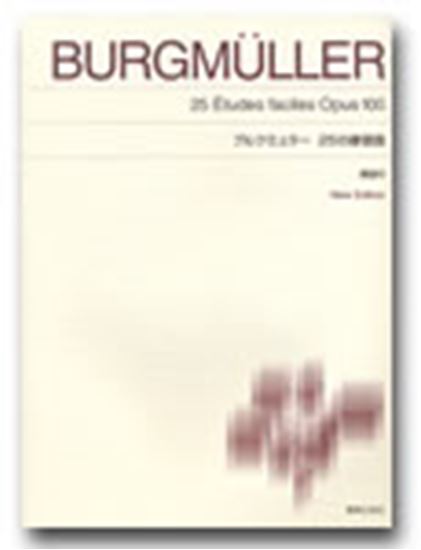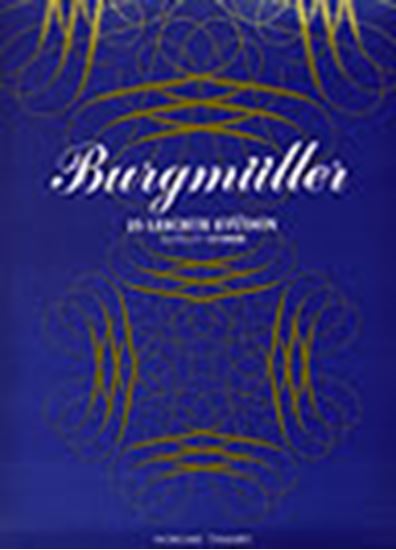Burgmüller, Johann Friedrich Franz : 25 Etudes faciles et progressives, conposées et doigtées expressément pour l'étendue des petites mains L'harmonie des anges Op.100-21
Work Overview
Genre:etude
Total Playing Time:1 min 30 sec
Copyright:Public Domain
Additional Notes:表記ゆれの例: 天使の声 天使のこえ 天使の合唱 天使たちの合唱 天使のしらべ
Commentary (3)
Author : Sato, Takashi
Last Updated: January 31, 2022
[Open]
Author : Sato, Takashi
The rich, overtone-laden sound of arpeggios melting into the pedal evokes the reverberation of a grand cathedral, similar to that in No. 19, "Ave Maria". Is it a coincidence that a half cadence on the dominant of the submediant key is used again at the end of the middle section (bar 16)? Regarding the chord with sf in bar 30, editions with E-flat in the bass, interpreted as a "German sixth chord", were once common. However, recently, editions with E in the bass, interpreted as a "diminished seventh chord", following the original manuscript, have become more prevalent.
Performance Points (Original ♩=152)
This exercise focuses on smoothly transferring arpeggios from the left hand to the right hand, and from the right hand to the left hand. While large wave-like figures like those in bars 1 and 2 are fine, it becomes more challenging when large leaps occur during the transfer, as in bars 3 and 4. In bars 13-16, pay close attention to the contrary motion between the bass and the first finger of the right hand. The cresc. in bar 26 should be imagined with an allargando feel, accompanying the expansion of the right-hand's range. For the descending figure from beat 4 of bar 28, mentally bracket the auxiliary notes and play it as D-H-G-D-H.
(From To-on Edition "Burgmüller 25 Etudes" (NS70))
Author : Iida, Arisa
Last Updated: March 15, 2018
[Open]
Author : Iida, Arisa
Musical example provided by: Ongaku no Tomo Sha
Author : Ooi, Kazurou
Last Updated: May 23, 2019
[Open]
Author : Ooi, Kazurou
There are primarily two considerations when performing this piece: one is choreography (method of performance), and the other is pedaling. Choreography is a specialized and profound challenge, but when performing such an elegant piece, fluid, unhurried, and supple arm movements are required.
Choreography
Upon examining the score, it is in 4/4 time, with the left and right hands appearing alternately. There is no particular need to alter the left/right indications written in the score; it is perfectly acceptable to play as written. When a rest occurs, one hand takes over from the other, and at this point, the hand should be raised. While difficult to explain in writing, the aforementioned "fluid, unhurried, and supple arm movements" should be employed to achieve a visual effect. The audience (listeners/viewers) must never perceive any haste. The performance should convey a sense of unhurried grace and ample composure. This is the first point.
Pedaling
The second point concerns the use of the pedal. Fundamentally, the pedal should be depressed once per chord. If the chord changes, the pedal should be changed. For measures 1-2, the pedal should be sustained throughout each measure. Do not change it midway. Please refer to measure 3. This measure also consists of a single chord (C-E-G). The present author would sustain the pedal for the entire measure, but it is also permissible to depress it twice, for beats 1-2 and 3-4. The same applies to the subsequent measure.
Please refer to measure 5. The constituent chord is D-F#-A-C, which is a dominant seventh chord. However, a non-harmonic tone, B, which functions as a passing tone, is present here. This raises the issue of whether this will be noticeable if the pedal is sustained. The present author would sustain the pedal throughout the measure without concern, but if this presents a concern, one may change the pedal midway. However, doing so would result in the loss of the bass note on the first beat. Since the bass note occurs on the first beat, changing the pedal midway will automatically lead to its loss. Therefore, one may employ finger pedaling to sustain the left-hand note on the first beat. If the pedal is changed during this time, the bass will not be lost. Nevertheless, doing so would then compromise the choreography of the left hand (as the finger must remain on the key). It is recommended to sustain the pedal throughout the measure, accepting a slight degree of harmonic blurring.
Measure 6 presents a similar situation. Measure 7 has the same constituent notes, but it is slightly different. Here, by changing the pedal on the fourth beat, the harmonic blurring caused by the non-harmonic tone G between beats 2 and 3 can be resolved. In this instance, a bass note is present on the fourth beat, thus preventing the loss of the bass line.
Subsequently, please exercise your own judgment regarding pedal changes, adapting to the specific musical context.
Arrangements & Related Works(5)
Nakatani, Mikito: L'harmonie des anges
Total Performance Time: 2 min 00 sec
PTNA & Partner Channel Videos(19items) View More
Sheet MusicView More
Scores List (24)

(株)東音企画(バスティン)

(株)東音企画(バスティン)

(株)東音企画(バスティン)

(株)全音楽譜出版社

(株)ドレミ楽譜出版社

(株)音楽之友社

KMP(ケイ・エム・ピー) ケイエムピー

(株)ドレミ楽譜出版社

ハンナ(ショパン)

(株)ヤマハミュージックエンタテインメントホールディングス

デプロMP

(株)ドレミ楽譜出版社

(株)全音楽譜出版社

(株)ドレミ楽譜出版社

カワイ出版

カワイ出版

デプロMP

(株)ヤマハミュージックエンタテインメントホールディングス

デプロMP

(株)音楽之友社

(株)共同音楽出版社

Neil A. Kjos Music Company




















